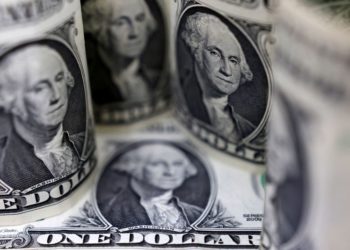By David Lawder and Andrea Shalal
WASHINGTON (Reuters) -U.S. Treasury Secretary Scott Bessent’s pledge of “large and forceful” actions to stabilize Argentina’s wobbling currency by using a 91-year-old U.S. crisis fund could help the peso find its footing, at least for a while.
Bessent’s backstop for Argentina with Treasury’s occasionally used $219.5 billion Exchange Stabilization Fund sent the peso and other Argentine assets soaring after major losses last week. But he said decisions on any U.S. intervention would come after he and President Donald Trump meet with Argentine President Javier Milei in New York on Tuesday.
“U.S. support for Argentina will provide a short-term boost both to the peso and the government’s standing in the midterm elections,” said Martin Muehleisen, a former International Monetary Fund strategy chief who is now a senior fellow at the Atlantic Council.
Muehleisen said any conditions Treasury adds to a loan or intervention could compound an already complicated debt situation for Argentina.
Such a loan from Washington might also push other creditors such as China back in the repayment line, experts say.
Treasury’s Exchange Stabilization Fund is a powerful tool that has helped ease numerous crises, backing Federal Reserve lending facilities during the 2020 COVID-19 pandemic and the 2008-2009 global financial crisis. It was also deployed to ease financial crises in Mexico and Brazil in the 1990s and Uruguay in 2002.
It was created in 1934 to stabilize the dollar’s value during the Great Depression after a reduction in the greenback’s gold weighting. With authorization from the Treasury secretary, it can be used for the purchase or sale of foreign currency, issuing loans or credit to foreign governments or entities or acquiring and using Special Drawing Rights (SDRs), the IMF’s reserve asset.
Bessent’s pledge to support Milei partly reflects Trump’s affinity for the right wing leader, who attended Trump’s inauguration in January and who has embarked on a range of private sector reforms to try to revive Argentina’s economy.
Washington’s support also contrasts sharply with the Trump administration’s treatment of Brazil’s leftist government over its prosecution of former right-wing President Jair Bolsonaro.
BACKSTOP OF CHOICE
As of July 31, the ESF had total assets of $219.5 billion, but the readily available liquid assets are far lower since $173.7 billion of the total is in IMF SDRs.
Brad Setser, a trade and currency expert with the Council on Foreign Relations, estimates that the readily available firepower in the ESF is just under $30 billion, comprising $21.9 billion in Treasury securities, $1.6 billion in cash and $5.7 billion in foreign currency holdings.
That’s likely more than enough to stem a crisis for a country like Argentina, which is not a systemically critical part of the global financial system.
The Treasury last pledged ESF funds in March 2023 – $25 billion – to back a new Fed bank emergency liquidity program after Silicon Valley Bank and Signature Bank failed. The Fed’s Bank Term Funding Program shut down after a year.
As the COVID-19 pandemic erupted in March 2020, the Treasury pledged $10 billion in ESF capital to back a new Fed commercial paper funding facility to help businesses manage their liquidity during the sharp economic downturn.
In September 2008, the Treasury pledged $50 billion from the ESF to backstop money market mutual funds that were seeing unprecedented withdrawals. The Treasury also has occasionally dipped into the ESF during U.S. debt ceiling crises to avoid breaching the limit.
FOREIGN INTERVENTIONS
The ESF was last used to intervene in foreign currencies in 2011, when Treasury joined a coordinated action by G7 countries to stem the rise of Japan’s yen after a deadly earthquake.
The fund’s biggest foreign currency intervention took place after Mexico’s 1994 peso crisis when President Bill Clinton authorized $20 billion from the ESF to guarantee loans to Mexico. The loans were also backed by future Pemex oil revenues and were repaid early in 1997.
Similar actions were taken in 1998 on behalf of Brazil and in 2002 for Uruguay, which received a $1.4 billion bridge loan that was repaid with IMF and World Bank funds.
USES FOR ARGENTINA
Demand for such bridge loans has faded in recent years due to improvements in IMF and World Bank processes and programs, analysts said, but the Treasury could use the ESF to set up a stabilization credit facility for Argentina, or intervene directly in markets to buy up pesos or dollar debt.
Although Bessent said that a central bank swap line is among tools that could be deployed, the Treasury does not have direct control over swap lines.
That remains the purview of the Federal Reserve and its swap lines have been designed more to avoid global contagion and blow-back from foreign crises into the U.S. economy. Bessent on Monday said he did not expect contagion from the Argentine crisis.
A Fed spokesperson declined to comment on the possibility of a U.S.-Argentina swap line.
Bessent’s offer of support without conditions such as fixing the problem of an over-valued peso may be “a way of just financing capital flight for little purpose,” said Mark Sobel, a former U.S. Treasury and IMF official who is now U.S. chairman of the Official Monetary and Financial Institutions Forum think tank.
Sobel added that it will be a challenge to overcome investors’ long-embedded urge to flee Argentina during a crisis.
“Markets have had over 100 years of Argentine over-borrowing, hyperinflation and serial defaults, and so when Argentina hits the skids, investors remember that,” he said. “And they’re not going to go, ‘Milei is different.'”
(Reporting by David Lawder and Andrea Shalal; additional reporting by Rodrigo Campos in New York and Howard Schneider in Washington; Editing by Sam Holmes)
The post Analysis-US Treasury’s support for Argentina gives peso, Milei friendly leg-up, for now appeared first on Reuters.




